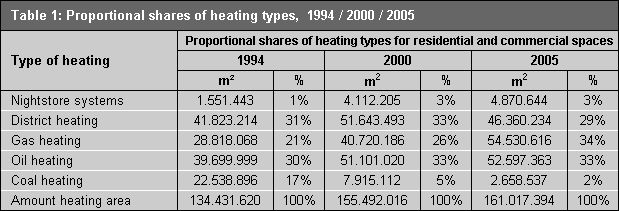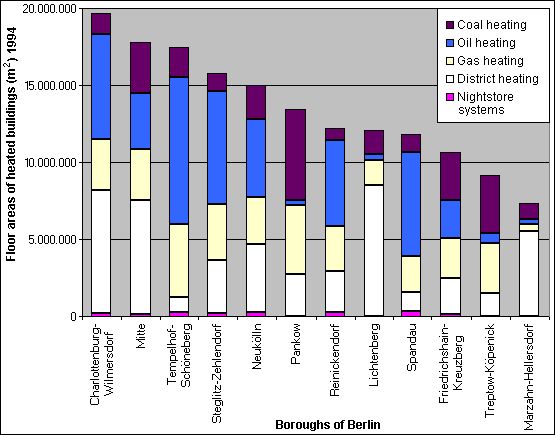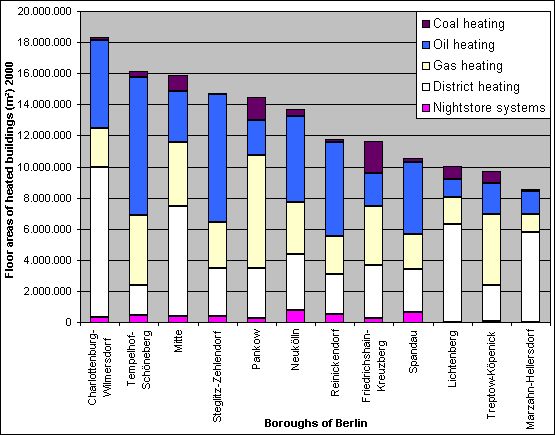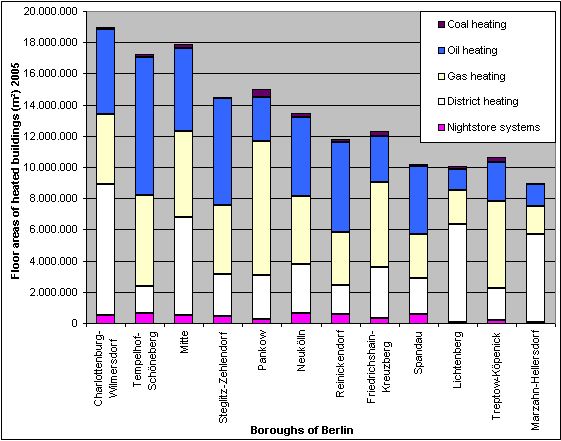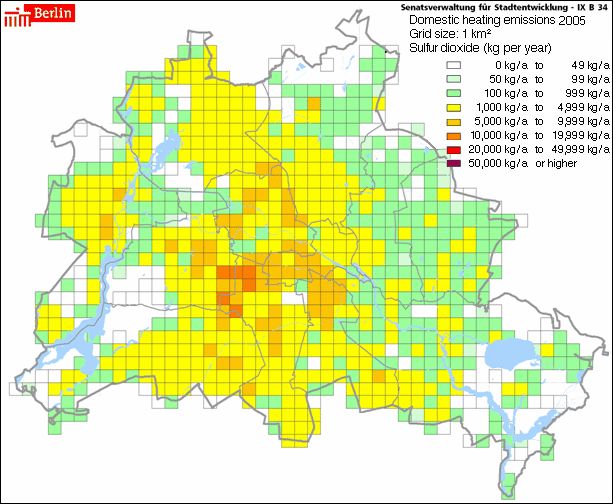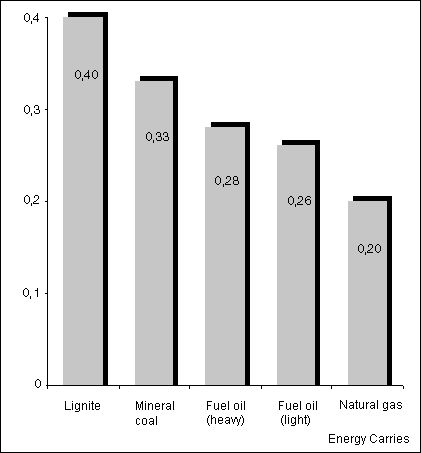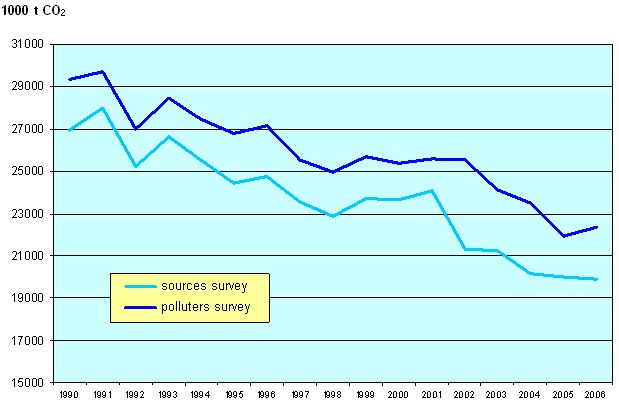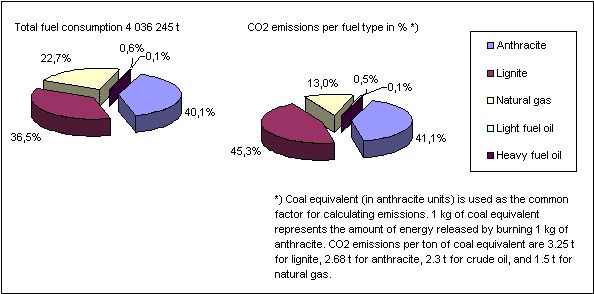Types of Fuel for Generating Building Heat
On account of the close relationship between the topics covered in Maps 08.01 – “Building Heating Supply Areas” (Edition 2010) and 08.02 – “Predominant Heating Types” (Edition 2010), a common text has been prepared for both maps.
Berlin is the largest contiguous built-up conurbation in Germany. Approximately 3.4 million inhabitants live in an area of 889 km2 (December 2009). The development of heating and heat supply to residential and commercial buildings, as well as the distribution of the various kinds of fuel, are tied to the evolution of the city and are characterized by its social structure and development history.
In the course of the industrialization period after 1875 and the dramatic population increase which this brought with it, Berlin’s old city center (within the present City-Rail Circle Line) developed largely into a city of tenements. On the edge of the inner city, the housing construction companies’ first settlements emerged. In the outer areas, villa colonies and garden city projects were built. Until the end of World War Two, the city’s heating fuel supply relied almost exclusively on lignite and anthracite.
Post-war development was marked by large-scale reconstruction and new building projects, which initially used row construction. From the 1960s to the 1980s, large developments and satellite towns emerged in the outer areas, while the inner city’s housing programs were initially characterized by demolition and construction from scratch. Starting in the mid-1970s, preservation-oriented forms of urban renewal were undertaken, primarily in Wedding and Kreuzberg (cf. Map 06.07, SenStadtUm 2008b). The use of different fuel types for the heating of residential buildings and workplaces developed differently in East and West Berlin during this period.
West Berlin
In the western part of Berlin, coal was increasingly being replaced with other energy sources after the early 1970s. The choice of a substitute fuel type largely depended on local housing structures: in single-family and duplex homes in the outer areas, the primary fuel type used for heating was light fuel oil. For the heating of residential apartment buildings and workplaces, fuel types were chosen largely by proximity to heating supply networks (in the case of energy providers with pipe networks). In-plant oil-fired heating units were also common.
Until 1989, the large number of heating power plants in insular West Berlin facilitated a continuous development of district heating, which was supplied by the Berlin Electric Power Company (BEWAG). As BEWAG was traditionally focused on supplying electricity, however, optimization of its thermal technology structures has proven difficult.
East Berlin
In the eastern part of Berlin, heating relied almost exclusively on lignite and natural gas up to 1989 – in single-family and duplex housing areas and in multi-story old building quarters, but also in workplaces. Approx. 60 percent of the apartments in the eastern part of Berlin were provided with self-contained and/or communal coal heating in 1989; approx. 40 percent of the apartments were provided with district heat from heating plants and heating power plants. Because of usage restrictions in the former GDR, fuel oil was not made available to the heating market.
Berlin After 1989
After 1989, city development in the reunited metropolis experienced several different stages. Between 1991 and 2000, approx. 150,000 new apartments were built. Approx. 60 percent of the newly erected buildings were a part of existing larger compounds. By 1992, construction of existing tower block building projects in the east of the city was completed. In the west, there was little activity in city development. Between 1993 and 1997, numerous major construction projects were undertaken, for example new suburbs in outer areas such as the former farmlands of Karow-Nord, and prestigious inner city projects such as Potsdamer Platz and the new government buildings. Since 1997, the number of new development projects has been declining throughout the conurbation. As a result of the decrease in city development funding, the number of new construction projects in 2003 was almost as low as in 1991. Following a boom of home building in the eastern outer areas and surrounding regions in 1998/1999, this area of development has also begun to stagnate. Nearly 80 percent of the expansive tower block developments in East Berlin, as well as many of the inner city’s old building quarters, have been rehabilitated with the help of state funding (structural renovations, improved residential interiors).
Energy politics, and with them the local heat supply market, changed radically after 1989. Whereas West Berlin’s insular geographical position and East Berlin’s centralized control structures had previously ensured well-defined supply networks, the city’s unification had a destabilizing influence on the supply of energy throughout the city. Berlin was hurriedly linked into the country’s nationwide power and gas networks, and in 1997, Berlin’s main energy supplier BEWAG changed from predominantly public ownership to being fully privatized. The Energy Law amendment of 1998 created new conditions for the domestic power and gas market (cf. Bundesministerium für Wirtschaft und Arbeit 2004). However, market tendencies until the end of 2003 have shown that Berlin’s established energy suppliers BEWAG and GASAG continue to supply the main bulk of power, district heat and gas. In January 2006 the Bewag stock corporation became the Vattenfall Europe Berlin stock corporation.
Also since 1989, the Berlin Senate has widely advanced its energy politics to respond to global climate changes and optimize the use of energy in the local generation of heat. Measures have included:
- A new bill to encourage economical as well as environmentally and socially viable energy supply and use (cf. Berlin Energiespargesetz – BEnSpG).
- Energy white paper 1990-1996 to assess the measures of the 1994 Energy Concept (cf. Energiebericht 1990-1996).
- Collation and agreement of a State Energy Program 2000-2003. This also stipulated as a public service the creation and maintenance of the Environmental Atlas Maps contained herein. On the 18th of July 2006 the State Energy Program 2006-2010 was enacted by the federal state government as an updated version.
- Numerous other activities and initiatives towards energy usage reductions and energy optimization in the field of building heating (cf. in-depth reports in “Klimaschutz – Schwerpunkte in Berlin” (only in German)).
A comparison of our last survey from 1994/95 to the data collected on heating-related energy consumption in 2000 (see table 1) demonstrates vividly the progress that has been made since the introduction of state-funded and private/corporate measures in the field of building heating.
It is visible that especially in the nineties coal was substituted by other heating types, while between 2000 and 2005 the change from district heating to gas heating is noticeable. Emission-reducing measures for domestic heating have proven more effective than for industrial production sites and power plants, as is shown by the lowered emission figures.

